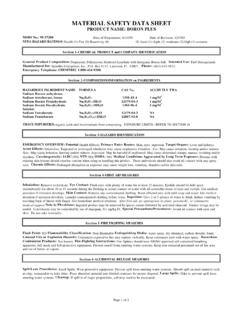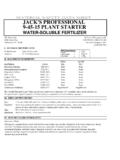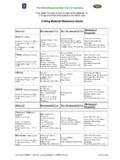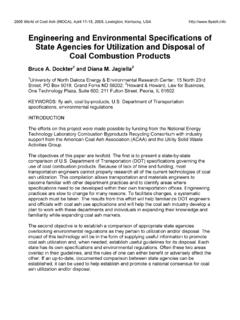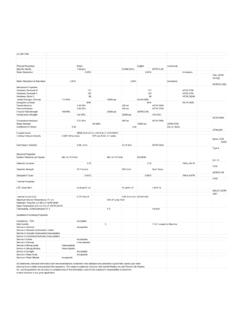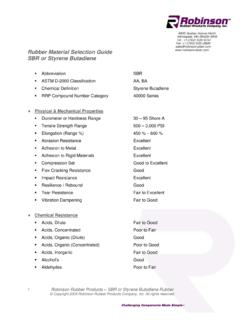Transcription of PRODCUT NAME: Nutralyze (12-0-0-26S) - Spindler …
1 MATERIAL SAFETY DATA SHEET PRODCUT name : Nutralyze (12-0-0-26S) Page 1 of 3 MSDS No.: 99-57129 Date of Preparation: 12/3/02 NFPA HAZARD RATINGS: Health (0) Fire (0) Reactivity (0) (0) least (1) slight (2) moderate (3) high (4) extreme Section 1-CHEMICAL product and COMPANY IDENTIFICATION General product Composition: Inorganic Salt Solution of Ammonium Thiosulfate. Intended Use: Turf for: Spindler Enterprises, Inc., Box 6112, Lakeland, Fl. 33807. Phone: (863) 619-9822. Emergency Telephone: CHEMTREC 1-800-424-9300.
2 Section 2-COMPOSITION/INFORMATION on INGREDIENTS Composed of 60% Ammonium Thiosulfate and 40% Water Ingredients in this product are not considered hazardous under OSHA Hazardous Communication Standard Section 3-HAZARDS IDENTIFICATION EMERGENCY OVERVIEW: Potential Health Effects: Primary Entry Routes: Eyes, skin, ingestion, inhalation. Target Organs: Eyes, skin, gastrointestinal tract, respiratory tract. Acute Effects: Inhalation: product mist may irritate the respiratory tract Eye: product mist or solution will cause irritation or a burning sensation.
3 Skin: Possible irritation form prolonged or repeated contact. Ingestion: May irritate the gastrointestinal tract. If product is heated, ammonia gas may be given off. This gas can be highly irritating to the eyes and throat. Avoid the inhalation of any product vapors. Carcinogenicity: IARC: NO, NTP: NO, OSHA: NO. Section 4-FIRST AID MEASURES Inhalation: Remove to from contaminated atmosphere. If breathing is labored, administer oxygen. If breathing has ceased, clear airway and start mouth-to-mouth resuscitation.
4 If heart has stopped beating, external heart massage should be applied. Obtain medical attention. Eye Contact: Flush eyes with plenty of water for at least 15 minutes. Hold eyelids apart during irrigation to ensure thorough flushing of the entire area of the eye and lids with water. Get immediate medical attention if irritation persists. Skin Contact: Immediately flush with large quantities of water. Remove contaminated clothing under shower. Obtain immediate medical attention. Ingestion: In victim is conscious, give 2 to 4 glasses of water, and induce vomiting by touching finger to back of throat.
5 Special Precautions/Procedures: None known. Section 5-FIRE FIGHTING MEASURES Flash Point: NA. Flash Point Method: NA. Burning Rate: NA. Auto ignition Temperature: NA. LEL: ND. UEL: ND. Flammability Classification: Non-flammable. Extinguishing Media: As appropriate for combustibles in area. Unusual Fire or Explosion Hazards: Heating to dryness will cause the release of ammonia, hydrogen sulfide and oxides of sulfur. Ammonia (16-25%) and hydrogen sulfide (4-46%) may form flammable mixtures with Hazardous Combustion Products: See Explosion Hazards.
6 Section 6-ACCIDENTAL RELEASE MEASURES Spill/Leak Procedures: Small Spills: Absorb spill with sand, earth, sweeping compound or other inert absorbant. Dispose on in accordance with all government regulations. Large Spills: Dike to prevent spill from entering water systems. Recover as much solution as possible. Flush residue to soil with large quantity, if permitted by applicable disposal regulations. Section 7- HANDLING and STORAGE Handling Precautions: Avoid contact with skin, eyes and clothing.
7 Do not take internally. Wash after handling. Do not contaminate water by disposal of equipment wash waters. Storage Requirements: Store in a cool, dry area preferably locked and out of reach of children and animals. MATERIAL SAFETY DATA SHEET PRODCUT name : Nutralyze (12-0-0-26S) Page 2 of 3 Section 8-EXPOSURE CONTROLS/PERSONAL PROTECTION Occupational Exposure Limits: None established for this product . ACGIH limits for ammonia are TWA 25 ppm and STEL 35 ppm. The OSHA limit for ammonia is 35 ppm STEL.
8 Respiratory Protection: In confined areas, NIOSH/MSMA approved respirator. Protective Clothing/Equipment: Respiratory Protection: None generally required. If conditions exist where mist might be generated, a mist respirator should be used. Protective Clothing: Rubber gloves and apron should be used to avoid prolonged or repeated contact with the liquid. Chemical safety goggles or a full-face shield are recommended to avoid contact with eyes. Do not wear contact lenses. Additional Protective Measures: NIOSH approved self-contained breathing apparatus should be available to fire fighters working in an area where this product is stored.
9 Section 9-PHYSICAL/CHEMICAL PROPERTIES Physical State: Liquid. Appearance & Odor: Colorous, pale yellow to green solution with slight ammonia odor. Boiling Point: 210-220oF Solubility in Water: Soluble. Specific Gravity (@68oF): pH (@68oF): Vapor Pressure (mm Hg): 18 at 70oF Section 10-STABILITY AND REACTIVITY Stability: Stable under normal conditions of use and storage. DO NOT FREEZE. Polymerization: NO. Chemical Incompatibilities: Contact with strong oxidizers such as chlorates, nitrate and nitrites may cause explosions or the release of ammonia, hydrogen sulfide or sulfur oxides.
10 Contact with strong acids will cause the release of sulfur dioxide. Contact with strong alkalies will cause the evolution of ammonia. Avoid storage near oxidizers, strong acids or strong alkalies. Solution is not compatible with copper, zinc, tin or their alloys. These materials of construction should not be used in handling systems for the product . Conditions to Avoid: Extreme heat. Freezing temperatures. Hazardous Decomposition Products: Heating the product will evolve ammonia. Heating to dryness will cause the evolution of ammonia, hydrogen sulfide and sulfur dioxide.
